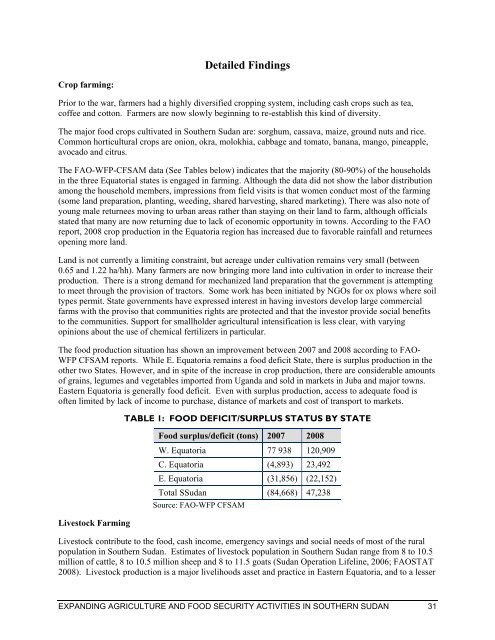expanding agriculture and food security activities in ... - part - usaid
expanding agriculture and food security activities in ... - part - usaid
expanding agriculture and food security activities in ... - part - usaid
Create successful ePaper yourself
Turn your PDF publications into a flip-book with our unique Google optimized e-Paper software.
Crop farm<strong>in</strong>g:<br />
Detailed F<strong>in</strong>d<strong>in</strong>gs<br />
Prior to the war, farmers had a highly diversified cropp<strong>in</strong>g system, <strong>in</strong>clud<strong>in</strong>g cash crops such as tea,<br />
coffee <strong>and</strong> cotton. Farmers are now slowly beg<strong>in</strong>n<strong>in</strong>g to re-establish this k<strong>in</strong>d of diversity.<br />
The major <strong>food</strong> crops cultivated <strong>in</strong> Southern Sudan are: sorghum, cassava, maize, ground nuts <strong>and</strong> rice.<br />
Common horticultural crops are onion, okra, molokhia, cabbage <strong>and</strong> tomato, banana, mango, p<strong>in</strong>eapple,<br />
avocado <strong>and</strong> citrus.<br />
The FAO-WFP-CFSAM data (See Tables below) <strong>in</strong>dicates that the majority (80-90%) of the households<br />
<strong>in</strong> the three Equatorial states is engaged <strong>in</strong> farm<strong>in</strong>g. Although the data did not show the labor distribution<br />
among the household members, impressions from field visits is that women conduct most of the farm<strong>in</strong>g<br />
(some l<strong>and</strong> preparation, plant<strong>in</strong>g, weed<strong>in</strong>g, shared harvest<strong>in</strong>g, shared market<strong>in</strong>g). There was also note of<br />
young male returnees mov<strong>in</strong>g to urban areas rather than stay<strong>in</strong>g on their l<strong>and</strong> to farm, although officials<br />
stated that many are now return<strong>in</strong>g due to lack of economic opportunity <strong>in</strong> towns. Accord<strong>in</strong>g to the FAO<br />
report, 2008 crop production <strong>in</strong> the Equatoria region has <strong>in</strong>creased due to favorable ra<strong>in</strong>fall <strong>and</strong> returnees<br />
open<strong>in</strong>g more l<strong>and</strong>.<br />
L<strong>and</strong> is not currently a limit<strong>in</strong>g constra<strong>in</strong>t, but acreage under cultivation rema<strong>in</strong>s very small (between<br />
0.65 <strong>and</strong> 1.22 ha/hh). Many farmers are now br<strong>in</strong>g<strong>in</strong>g more l<strong>and</strong> <strong>in</strong>to cultivation <strong>in</strong> order to <strong>in</strong>crease their<br />
production. There is a strong dem<strong>and</strong> for mechanized l<strong>and</strong> preparation that the government is attempt<strong>in</strong>g<br />
to meet through the provision of tractors. Some work has been <strong>in</strong>itiated by NGOs for ox plows where soil<br />
types permit. State governments have expressed <strong>in</strong>terest <strong>in</strong> hav<strong>in</strong>g <strong>in</strong>vestors develop large commercial<br />
farms with the proviso that communities rights are protected <strong>and</strong> that the <strong>in</strong>vestor provide social benefits<br />
to the communities. Support for smallholder agricultural <strong>in</strong>tensification is less clear, with vary<strong>in</strong>g<br />
op<strong>in</strong>ions about the use of chemical fertilizers <strong>in</strong> <strong>part</strong>icular.<br />
The <strong>food</strong> production situation has shown an improvement between 2007 <strong>and</strong> 2008 accord<strong>in</strong>g to FAO-<br />
WFP CFSAM reports. While E. Equatoria rema<strong>in</strong>s a <strong>food</strong> deficit State, there is surplus production <strong>in</strong> the<br />
other two States. However, <strong>and</strong> <strong>in</strong> spite of the <strong>in</strong>crease <strong>in</strong> crop production, there are considerable amounts<br />
of gra<strong>in</strong>s, legumes <strong>and</strong> vegetables imported from Ug<strong>and</strong>a <strong>and</strong> sold <strong>in</strong> markets <strong>in</strong> Juba <strong>and</strong> major towns.<br />
Eastern Equatoria is generally <strong>food</strong> deficit. Even with surplus production, access to adequate <strong>food</strong> is<br />
often limited by lack of <strong>in</strong>come to purchase, distance of markets <strong>and</strong> cost of transport to markets.<br />
Livestock Farm<strong>in</strong>g<br />
TABLE 1: FOOD DEFICIT/SURPLUS STATUS BY STATE<br />
Food surplus/deficit (tons) 2007 2008<br />
W. Equatoria 77 938 120,909<br />
C. Equatoria (4,893) 23,492<br />
E. Equatoria (31,856) (22,152)<br />
Total SSudan (84,668) 47,238<br />
Source: FAO-WFP CFSAM<br />
Livestock contribute to the <strong>food</strong>, cash <strong>in</strong>come, emergency sav<strong>in</strong>gs <strong>and</strong> social needs of most of the rural<br />
population <strong>in</strong> Southern Sudan. Estimates of livestock population <strong>in</strong> Southern Sudan range from 8 to 10.5<br />
million of cattle, 8 to 10.5 million sheep <strong>and</strong> 8 to 11.5 goats (Sudan Operation Lifel<strong>in</strong>e, 2006; FAOSTAT<br />
2008). Livestock production is a major livelihoods asset <strong>and</strong> practice <strong>in</strong> Eastern Equatoria, <strong>and</strong> to a lesser<br />
EXPANDING AGRICULTURE AND FOOD SECURITY ACTIVITIES IN SOUTHERN SUDAN 31

















